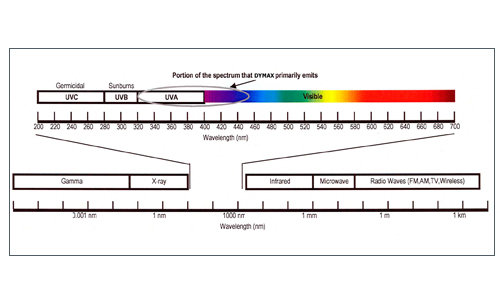The Differences Between UVA, UVB, and UVC Ultraviolet Light
Dymax light-curable materials polymerize upon exposure to ultraviolet (UV) light to transition them from a liquid into a cured, solid state. A product’s formulation will determine what range of the UV spectrum it will be able to cure in. For this reason, it’s important to have a basic understanding of the different types of UV light that exist.
Ultraviolet light is a form of energy that occupies a small portion of the electromagnetic radiation spectrum, with a shorter wavelength than visible light and a longer wavelength than X-rays. Wavelengths in these regions are commonly measured in nanometers (nm), which are a billionth of a meter or a thousandth of a micron. UV ranges from about 200-400 nm and is separated into three regions, UV-A, UV-B, and UV-C. UV occurs naturally in sunlight but can also be found in many man-made systems.
The diagram below illustrates that Dymax adhesives, coatings, and other light-curable materials cure primarily in the UVA / Visible portion of the spectrum.
Here's an overview of the different UV wavelengths and the basic pros and cons associated with each.
UV-A
- 400-320 nm long wavelength
- Generally considered the safest of the UV ranges
- Accounts for 90-95% of UV radiation on Earth
- Commonly used to polymerize UV adhesives and in fluorescent inspection processes
UV-B
- 320-280 nm medium wavelength
- Primary cause of sunburn and skin cancer
- Accounts for 5-10% of UV radiation on Earth
- Often used to cure UV inks and lacquers because UVB helps eliminate surface tack
UV-C
- 280-200 nm short wavelength
- Most damaging UV but does not reach Earth as it’s filtered out by our atmosphere
- Found in man-made sources like welding torches and some mercury bulbs
- Commonly used for sterilization and germicidal applications
Always remember to protect yourself when working with UV Light
Many people often mistake the bright light coming off UV systems as harmful, but what the eyes are seeing is harmless visible light. UV light is invisible to the human eye and does not trigger the natural defenses of the eyes. For this reason, it is important to always wear personal protective equipment when working with UV light.
For more information about light-curing technology, download a copy of our comprehensive guide.
_________________________________________________________
Enjoying This Content? Let’s Stay Connected.
If you’re finding value in our insights, why not get more of it—delivered right to your inbox? Subscribe to receive the latest technical articles, white papers, product news, and expert tips.

